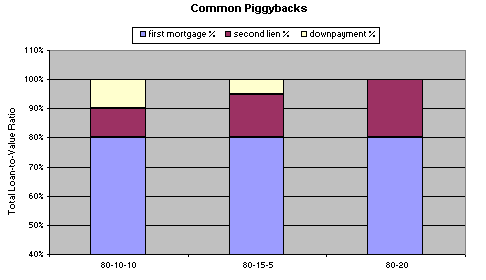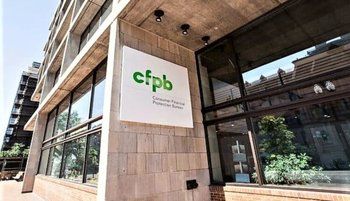Q: What is a piggyback mortgage?
A: piggyback mortgage is actually a package of two loans, one added on top of the other. For residential properties, that usually means a first mortgage which covers 80% of the value of the property, plus a second lien which covers 10%, 15% or even the whole remaining 20% of the value of the home. The second loan -- which can be either fixed- or adjustable-rate -- is 'piggybacked' on top of the first loan.
Q: What's the point of a piggyback mortgage? Why not simply take one mortgage for 90%, 95% or even 100% of the value of the property?
A: A little (short and simplified) mortgage history may be helpful here.
In the past, if you had less than 20% of your own money to put up, financing probably wasn't available to you. It goes without saying that the less of your money you put toward the purchase of your home, the more risk the lender needs to shoulder.
Mortgages with small down payments represent a greater risk to the lender/investor, because a borrower with a lesser interest in the property may simply walk away (default) in the event of severe financial trouble. Mortgage insurance, or MI, helps to indemnify the lender/investor by covering a portion of the value of the property. If the borrower defaults, the MI will usually cover the costs of foreclosing on and repairing the property, as well as the costs for selling it.
Typically, if the lender must accept more risk, you'll pay a higher rate, higher fees, or both -- a sort of "risk premium." Back in the day, lenders were not eager to make loans in excess of an 80% Loan-to-Value ratio, since they couldn't easily be sold to the secondary market; essentially, the lender would have to keep your loan, and all of the risk of delinquency or default, for the entire term.

An MI policy serves several purposes. Primarily, it protects the lender who held the loan and makes it less difficult to sell the loan to investors. It also increases the cost of the loan, since the insurance premiums are added to the loan payments.
Unlike mortgage interest, though, premiums for a MI policy may or may not be not tax-deductible, and the smaller the downpayment you made, the higher the monthly premium cost for your MI. As a result, a 'piggyback' arrangement was developed to help borrowers with small down payments avoid having to pay MI premiums, instead exchanging them for tax-deductible interest payments.
Lenders benefited, too. Because the first mortgage was made at an 80% LTV level, it could be sold to secondary market loan buyers like Fannie Mae or Freddie Mac. The second lien could be either held in portfolio, or sold (with other such liens). The second lien usually had small dollar amounts and were made at comparatively high interest rates, so they were thought to have low risk and high profitability for the lender. However, whether made in conjunction with a first mortgage or originated at a later date, second-lien position loans fared very poorly in the last housing bust, and many lenders stopped offering these kinds of products.
Want to see what MI might cost? Visit our PMI Calculator.
Q: Aside from avoiding MI, are piggybacks used for other purposes?
A: Yes. Avoiding MI is still the most common use, but lenders have positioned these to appeal to borrowers who want to sidestep the higher loan amount, and therefore higher interest rate, of a jumbo mortgage. Lenders do this by making a first mortgage for an amount at or near the conforming limit (currently $806,500), and lending the rest as a second mortgage. A borrower facing a loan amount which would be considered a 'minor' jumbo -- for example, $850,000 -- might instead split that into two loans for $806,500 and $43,500. Instead of paying the one-eighth to one-quarter percent premium typically found on a jumbo mortgage's interest rate for the entire $850,000, the borrower instead gets a lower interest rate for much of his loan, and only a small portion carries a higher interest rate.
Clever lenders have also created a new twist, too -- the "instant" Home Equity Line of Credit (HELOC). Even a borrower who might be putting 20% down can be offered the chance to establish an equity access line at the time of the closing of the first loan. These are typically written for an additional 10% or more of the home's value. Since it's a line of credit, no money needs to be borrowed when the line is closed, so there are usually no interest costs to incur (although there may be minor loan fees).
Of course, interest on these HELOC funds would only remain tax deductible if they are used to "buy, build or substantially improve" the home. Interest on funds used for other purposes are no longer tax deductible since the passage of the Tax Cuts and Jobs Act of 2017.
Borrowers intrigued by this opportunity should be certain to carefully review the terms. Where the open market might offer a HELOC at, say the Prime Rate plus a margin of 0% (Prime+0), a piggybacked offering might not be offered at such favorable terms; such is often the price of convenience. As always, it's a good idea to read the fine print, since a loan with no up-front closing costs may impose annual 'maintenance' fees -- or even a penalty if you should refinance the whole mess within the first few years.
Related: HSH's Guide to Home Equity Loans and Lines of Credit (HELOCs)
Q: How is the piggyback mortgage constructed?
The original set-up for piggybacks was a fixed-rate first mortgage and fixed-rate second mortgage, but a variety of packages are possible. Common offerings include a fixed-rate first lien plus a variable-rate HELOC second lien, or an adjustable rate first lien with a fixed-rate second lien, or a deal in which both liens have adjustable rates.
Usually, the first mortgage portion is a long-term loan -- 15, 20 or even 30 years (the standard offerings available in the market). The second lien will likely amortize in 10, 15 or 20 years, or may be packaged as a "balloon". This aptly-named loan features payments are based on a longer term (such as 20 years), but the loan balloons (the remaining balance becomes due and fully payable) after a shorter time -- 10 years is common.
As we mentioned, it's a good idea to pay close attention to the terms being offered, especially if isn't for a "convenience" arrangement. After all, you could always get a line of credit in the open market later if you wish. Of course, if your piggyback isn't for convenience but rather a necessity, you'll be left to decide if the combined offering is in your best interest.
Originally, the "second" portion of the program was priced to make it very comparable to the cost of paying for MI on an "after-tax" basis. However, while some offerings may be priced to be equivalent, that doesn't necessarily mean that the interest rate for the second portion will be competitively priced, even if it may ultimately work to the borrower's advantage.
It's also necessary to note that the savings are produced on an after-tax basis, which is only available if your itemized expenses exceed the standard deduction which is available to you; that is, your total monthly or annual out-of-pocket cost may be identical to having a first mortgage with MI, and the benefit of taking the piggyback may be the tax deduction for the interest you pay on the second lien. If you don't or can't deduct the interest (if you don't itemize), you are no better off than if you had taken the loan with MI.
To see what a "Piggyback Second" might cost you, visit our Monthly Payment Calculator.
Q: What about prepaying the second lien -- or taking, then canceling, MI?
A: Part of the original appeal of the piggyback arrangement was that, unlike an MI policy, the second lien portion had a known term, meaning it would fully amortize and end at a known time and a known total cost. This was important, since many borrowers who were required to pay for an MI policy didn't know or weren't told that MI didn't have an auto-cancel clause (although it was possible to cancel it by soliciting your lender to do so). Some borrowers paid MI premiums for years after their mortgage's LTV had slipped below 80%, costing hundreds or even thousands of dollars in unnecessary premiums.
That changed in the late 1990s when the Homeowner's Protection Act mandated how and when MI would automatically "sunset" -- and brought to light the particulars of how to cancel your MI even before that occurred. (For more details on MI cancellation and lots more, you might read our Guide to Private Mortgage Insurance). After the passage of HPA, MI had a known cancellation point.
With that said, savvy borrowers decided that one way to play the piggyback arrangement was to prepay the second lien portion as a way to save on interest costs. Unfortunately for them, some piggybacks came with a prepayment penalty -- or more properly an early termination fee -- which offset at least some of the savings of paying off the lien more quickly.
Of course, those who selected the traditional method -- a first lien with MI -- also discovered that MI could be canceled more quickly, as well, provided market conditions were favorable and the value of their home rose appreciably in the first few years of ownership. For some borrowers this meant that their MI policy could be canceled by soliciting their lender after as little as two years.
Q: Which is better -- a piggyback, or a traditional loan with MI?
Either method has both advantages and drawbacks. For example, MI may be cancelable after a fairly short period of time through no effort on your part, aside from making your regular monthly payments. That is, if the value of your home has risen sharply, you may be able to cancel MI in just two years. You have no such option for the second lien arrangement, though; you signed on for a given number of payments to retire the lien, and that cannot be changed without a slug of cash to pay off the loan (or a refinance).
Of course, if you're not diligent about making your payments on time, your mortgage lender can refuse to cancel your MI. You could always refinance, of course, although there no guarantee that mortgage rates will be favorable for doing so. On the other hand, even if you're late occasionally with payments on your second lien, it will still have a fixed termination date and a known cost.
As we mentioned above, there can be tax benefits for a second lien versus MI situation, at least on a comparable basis, but only if you itemize on your tax return.
In the case of a 'convenience HELOC' arrangement, we suggest that there's nothing inherently wrong with this, provided that you get a deal no worse than what is available to you in the open market. Do keep in mind that should you select this feature, you might be hit with recurring annual or "low-or non-usage" fees even if you don't borrow any money against your home right away, and that the interest on any funds not used to "buy, build or substantially improve" your home don't qualify for tax deductibility.
Q: I heard a rumor that MI premiums may be tax-deductible. True or false?
A: From 2006 through 2017, the answer was yes. However, the deductibility of MI premiums isn't part of the tax code, and so is subject to the whims of Congress. While PMI premiums were deductible from 2006 through 2017, it wasn't clear if they would ever be made deductible again.
Then, in late 2019, so-called "extenders" added into the "Further Consolidated Appropriations Act, 2020" made PMI premiums retroactively deductible for tax years 2018 and also extended the deduction through tax year 2020 -- and it was then was extended again through tax year 2021. However, this extension expired with TY2022, so PMI costs are no longer deductible, at least at the moment.
We hope that this article gives you a basic working knowledge of piggyback mortgages.
Related links:



